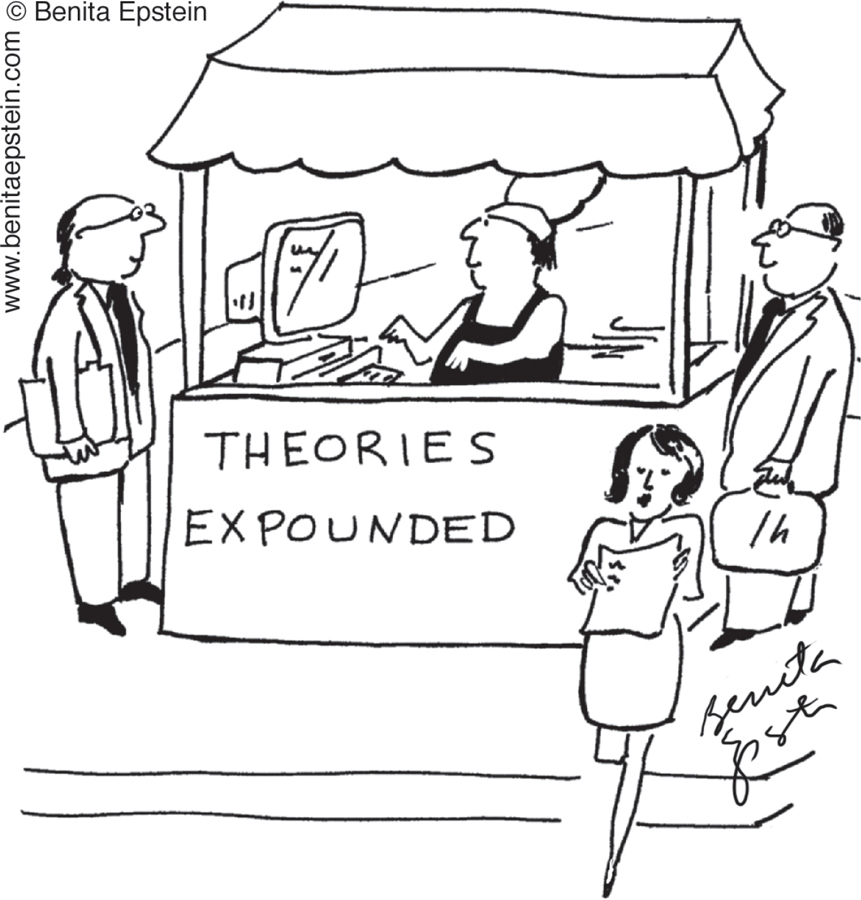2.5 Scientific Explanation
At the start of this chapter, we noted the purpose of research. Research fuels explanation, which is the ultimate goal of science (Salmon, 1989). Evidence from research provides the information needed to develop, test, and improve scientific explanations. In psychology, the purpose of research is to provide information that psychologists can use in explaining the behavior and experiences of people, the workings of the mind, and the functioning of the brain. Now that we’ve learned about psychology’s data, research designs, and forms of scientific evidence, let’s see how psychologists formulate scientific explanations.

Theories in Science
Preview Question
Question
 What is a scientific theory?
What is a scientific theory?
Scientists explain phenomena by developing sets of ideas known as scientific theories. What is a theory in science? A committee formed by the U.S. National Academy of Science has provided a particularly clear definition:
In everyday usage, “theory” often refers to a hunch or a speculation. When people say, “I have a theory about why that happened,” they are often drawing a conclusion based on fragmentary or inconclusive evidence.
The formal scientific definition of theory is quite different from the everyday meaning of the word. It refers to a comprehensive explanation of some aspect of nature that is supported by a vast body of evidence.
—National Academy of Sciences (2008, p. 11)
When scientists say they have a theory, it does not mean that they’re just speculating. A scientific theory is a systematic, data-
How do you suppose a theory differs from a hypothesis?
71
A theory may be broad or narrow in scope. Sigmund Freud (1900, 1930), for example, developed a theory of remarkable breadth; it was meant to explain the overall structure of mind, the development of children, psychological distress and personality differences among adults, and the relation between the individual and society. In contemporary psychological science, John Anderson and his colleagues have developed a theory designed to explain perception, memory, problem solving, and the development of skills (Anderson et al., 2004). Yet often, theories are narrowly focused. For example, one famous theory of the experience of pain (Melzack & Wall, 1965; see Chapter 5) is just that: a theory about one and only one psychological experience, pain.
WHAT DO YOU KNOW?…
Question 16
sAmxP0VmLF2wJdajVkTmktABzST/Mmy/klF7bpgd8igaxEqT1CRYTuEV7jCFLSDD2fA+UY7akqyqtzhYhFu15j0xzfEthXIVvF7QY9dd9Lz/mHlDs6hxHxmJ06X8GF6IyBt9BwOiVdYCYtKdWOPJtF7zBEigMnJf88ORIXeG1FKPOMTDILrLdKs6c92n3TVxhAib8gIERvfjiHiOnn9r4yJMJfSSwmBTboKDXzohSy+nDkaA6WcDFD0C0GG/43Xq03XlBK3qGAa3RqokjLu9/NM2y9pvYEgPwGPCoViaWtcCajrSqE6dorC3zDQ7mxQ/5/v3DCbcnU9Hznn1kNH5EQJNV3s=The Relation Between Theory and Evidence
Preview Question
Question
 What is the relation between theory and evidence?
What is the relation between theory and evidence?
Scientific theories and scientific evidence are connected by a two-
The results of research determine scientists’ level of confidence in their theories. If a theory generates hypotheses that repeatedly are confirmed, confidence in the theory grows. However, if a theory’s hypotheses are disconfirmed by evidence, the theory needs to be either modified or abandoned.
In this “direction of travel,” from theory to evidence, theory comes first and data are collected after a theoretical prediction is made. In practice, however, this sequence is less common than you might think. Science often proceeds in the opposite direction: Investigators (1) gather scientific data and then (2) try to devise a theory that explains important patterns in the collected data.
When traveling in this direction—
Become intimately familiar with … the data. Examine them from every angle. … If a datum suggests a new hypothesis, try to find additional evidence for it elsewhere in the data. If you see dim traces of interesting patterns, try to reorganize the data to bring them into bolder relief. … [Look for] something—
—Bem (1987, p. 172)
When you run onto something interesting, drop everything else and study it.
—B. F. Skinner (1956, p. 223)
You will see throughout this book that both directions of travel between theory and research have advanced the science of psychology.
72
WHAT DO YOU KNOW?…
Question 17
For each of the two scenarios below, specify whether the “direction of travel” is from theory to evidence or from evidence to theory.